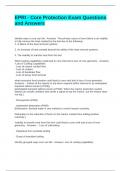Summary
LPC Notes BLP Tax Law Workbook Summary 2021 (BPP)
- Module
- BLP
Tax Workbook from BPP University (LPC) summarised. These notes are 10 pages long and summarise all the material that is found in your 136-page long workbook in a logical layout that is easy to understand. What these notes don't contain: SGS content and other solutions. What these notes do contai...
[Show more]












